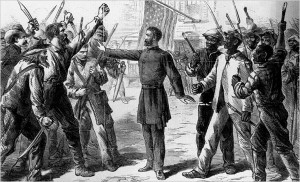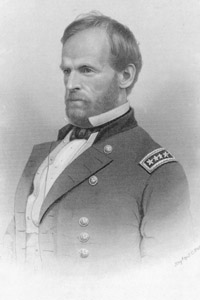 As noted in my last post, my A.P. United States history class is in the final phase of our Reconstruction Unit. Yesterday we opened class discussion with a reading they were assigned the night before from Elizabeth R. Bethel’s excellent book, Promiseland: A Century of Life in a Negro Community. Afterwards students organized into groups to do the following: 1) List the major issues facing Reconstruction; 2) Devise a 5-Step plan. They have already read about Lincoln’s Plan, the Radical Republicans plans, Wade-Davis Bill, ect., and along with the supplemental readings like Bethel’s, I felt like they had a good mix of information to create their own plans. They did a good job with the activity and the discussions were informative and at times elaborate. Here are some highlights as I remember them:
As noted in my last post, my A.P. United States history class is in the final phase of our Reconstruction Unit. Yesterday we opened class discussion with a reading they were assigned the night before from Elizabeth R. Bethel’s excellent book, Promiseland: A Century of Life in a Negro Community. Afterwards students organized into groups to do the following: 1) List the major issues facing Reconstruction; 2) Devise a 5-Step plan. They have already read about Lincoln’s Plan, the Radical Republicans plans, Wade-Davis Bill, ect., and along with the supplemental readings like Bethel’s, I felt like they had a good mix of information to create their own plans. They did a good job with the activity and the discussions were informative and at times elaborate. Here are some highlights as I remember them:
- Goal of Reconstruction: Students struggled with seeing Reconstruction as a success. It succeeded at reunited the nation, but utterly failed with regard to Blacks. So we discussed what was the goal of Reconstruction, the students said it was 1. Unity; 2. Recovery; 3. Equality. Problematic indeed. We talked about race and racism and that there was probably never a real chance at equality, and as the next 100 years will show. So we felt as a class, that Unity and Recovery were most likely the main intentions of Reconstruction. (Yes, some simplification here, but I tried to stay out of the discussion as much as possible and only intervened when I felt they were going up the wrong tree, I guess.) Some students overreached and designed plans that were, though thoughtful, not practical for 1860s and 1870s America.
- The End of Reconstruction: [I stole this from Kevin Levin]. I write on the board: “1876: Mission Accomplished.” This gets the intellectual juices flowing and some heady discussion usually follows. You can imagine the topics: Black Codes, Sharecropping, ect. The discussion here was about how the end brings out, perhaps, what the Civil War was about? The end of the fighting and how reconstruction was accomplished can maybe lend some light there?
A final discussion was about the legality of seizing Southern Plantations and giving the land to other people (former slaves). It was mainly one student who decided that as Slavery, though morally wrong, was not illegal when practiced by the South, so therefore did the United States have the right to sieze land? Clearly once the South rebelled they did, however, there was some interesting reasoning, though of course ultimately I don’t think the debate lasted.
All in all some great discussion.
 The end of our Civil War and Reconstruction unit is nearing and as we enter our discussion concerning Reconstruction we looked briefly at Sherman’s Field Order Number 15. To me this represents so much about Reconstruction. William T. Sherman clearly issued the order as a practicality to take care of the issue of all those new Southern laborers in need of subsistence, but also it furthered his desire to punish the Southern plantation elite. Some students did wonder if Sherman was capable of seeing this order as doing good for those former slaves [first and foremost] who desperately wanted their own land, and I felt that was a legitimate question that I could not answer. Sherman’s order is convoluted in terms of potential interpretation, is it not? It held so much hope for those poor Freedmen and in the end so much heartbreak. So in a way, the hope and failure of Sherman’s order represented, in a microcosm, the failure of Reconstruction.
The end of our Civil War and Reconstruction unit is nearing and as we enter our discussion concerning Reconstruction we looked briefly at Sherman’s Field Order Number 15. To me this represents so much about Reconstruction. William T. Sherman clearly issued the order as a practicality to take care of the issue of all those new Southern laborers in need of subsistence, but also it furthered his desire to punish the Southern plantation elite. Some students did wonder if Sherman was capable of seeing this order as doing good for those former slaves [first and foremost] who desperately wanted their own land, and I felt that was a legitimate question that I could not answer. Sherman’s order is convoluted in terms of potential interpretation, is it not? It held so much hope for those poor Freedmen and in the end so much heartbreak. So in a way, the hope and failure of Sherman’s order represented, in a microcosm, the failure of Reconstruction.